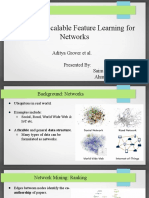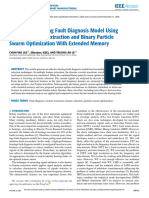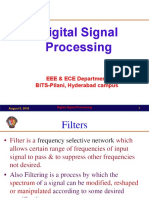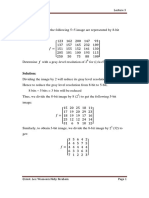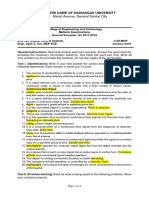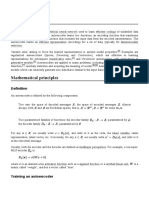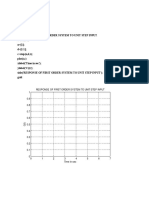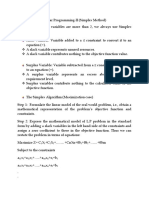06/10/2024
Spark Mllib
Instructor: Van-Dang Tran, Ph.D.
MACHINE LEARNING
“Programming Computers to optimize
performance using Example Data or Past
Experience”
1
� 06/10/2024
MACHINE LEARNING?
Field of study that gives "computers
the ability to learn without being
explicitly programmed."
-- Arthur Samuel, 1959
HAVE YOU PLAYED MARIO?
How much time did it take you to learn & win the princess?
2
� 06/10/2024
HOW ABOUT AUTOMATING IT?
How about
automating it?
Program Learns to Play Mario
Observes the game & presses keys
Maximises Score
3
� 06/10/2024
So?
• Program Learnt to play Mario and other games
• Without any need of programming
4
� 06/10/2024
Question: To make this program learn any other games such
as PacMan we will have to …
1. Write new rules as per the game
2. Just hook it to new game and let it play for a while
Question: To make this program learn any other games such as
PacMan we will have to …
1. Write new rules as per the game
2. Just hook it to new game and let it play for a while
10
5
� 06/10/2024
MACHINE LEARNING
• Branch of Artificial Intelligence
• Design and Development of Algorithms
• Computers Evolve Behaviour based on Empirical Data
Spark-MLb
il
11
MACHINE LEARNING - APPLICATIONS
Recommend Friends, Dates, Products to end-user.
12
6
� 06/10/2024
MACHINE LEARNING - APPLICATIONS
Classify content into predefined groups.
13
MACHINE LEARNING - APPLICATIONS
Identify key topics in large Collections of Text.
14
7
� 06/10/2024
MACHINE LEARNING - APPLICATIONS
Computer Vision - Identifying Objects
15
MACHINE LEARNING - APPLICATIONS
Natural Language Processing
16
8
� 06/10/2024
MACHINE LEARNING - APPLICATIONS
• Find Similar content based on Object Properties.
• Detect Anomalies within given data.
• Ranking Search Results with User Feedback Learning.
• Classifying DNA sequences.
• Sentiment Analysis/ Opinion Mining
• BioInformatics.
• Speech and HandWriting Recognition.
17
MACHINE LEARNING - TYPES?
Given example inputs & outputs, learn to
Supervised
map inputs to outputs
Machine Learning
18
9
� 06/10/2024
MACHINE LEARNING - TYPES?
Supervised Given example inputs & outputs, learn
to map inputs to outputs
Machine Learning Unsupervised No labels given, find structure
19
MACHINE LEARNING - TYPES?
Supervised
Given example inputs & outputs, learn
to map inputs to outputs
Machine Learning Unsupervised No labels given, find structure
Reinforcement
Dynamic environment, perform a certain
goal
20
10
� 06/10/2024
MACHINE LEARNING - TYPES?
Classification
Supervised
Regression
Machine Learning Unsupervised Clustering
Reinforcement
21
MACHINE LEARNING - CLASSIFICATION?
Check
Email
Spam? No
Yes We Use Logistic Regression
22
11
� 06/10/2024
MACHINE LEARNING - REGRESSION?
Predicting a continuous-valued
attribute associated with an object.
In linear regression, we draw all possible lines
going through the points such that it is closest
to all.
23
MACHINE LEARNING - CLUSTERING?
• To form a cluster based on
some definition of nearness
24
12
� 06/10/2024
MACHINE LEARNING - TOOLS
DATA SIZE CLASSFICATION TOOLS
Lines Sample Data Analysis and Whiteboard,…
Visualization
KBs - low MBs Prototype Analysis and Matlab, Octave, R,
Data Visualization Processing,
MBs - low GBs NumPy, SciPy,
Analysis
Online Data Weka,
Flare, AmCharts,
Visualization
Raphael, Protovis
GBs - TBs - PBs Analysis MLlib, SparkR, GraphX,
Big Data Mahout, Giraph
25
MACHINE LEARNING USING SPARK
• Spark RDDs à efficient data sharing
• In-memory caching accelerates performance
• Up to 20x faster than Hadoop
• Easy to use high-level programming interface
• Express complex algorithms ~100 lines.
26
13
� 06/10/2024
MACHINE LEARNING LIBRARY (MLlib)
Goal is to make practical machine learning scalable and easy
Consists of common learning algorithms and utilities, including:
• Classification
• Regression
• Clustering
• Collaborative filtering
• Dimensionality reduction
• Lower-level optimization primitives
• Higher-level pipeline APIs
27
MlLib STRUCTURE
ML Algorithms Featurization
Common learning algorithms
e.g. classification, regression, clustering, Feature extraction, Transformation, Dimensionality
and collaborative filtering reduction, and Selection
Pipelines Persistence
Tools for constructing, evaluating, Saving and load algorithms, models,
and tuning ML Pipelines and Pipelines
Utilities
Linear algebra, statistics, data handling, etc.
28
14
� 06/10/2024
MLLIB - COLLABORATIVE FILTERING
• Commonly used for recommender systems
• Techniques aim to fill in the missing entries of a user-item association
matrix
• Supports model-based collaborative filtering,
• Users and products are described by a small set of latent factors that can
be used to predict missing entries.
• MLlib uses the alternating least squares (ALS) algorithm to learn these
latent factors.
29
PIPELINES
DataFrame:This ML API uses DataFrame from Spark SQL as an ML dataset, which can hold a
variety of data types. E.g., a DataFrame could have different columns storing text, feature vectors,
true labels, and predictions.
Transformer: A Transformer is an algorithm which can transform one DataFrame into another
DataFrame. E.g., an ML model is a Transformer which transforms a DataFrame with features into a
DataFrame with predictions.
Estimator: An Estimator is an algorithm which can be fit on a DataFrame to produce a Transformer.
E.g., a learning algorithm is an Estimator which trains on a DataFrame and produces a model.
Pipeline: A Pipeline chains multiple Transformers and Estimators together to specify an ML
workflow.
Parameter: All Transformers and Estimators now share a common API for specifying parameters.
30
15
� 06/10/2024
PIPELINES
31
spark.mllib - BASIC STATISTICS
Summary statistics
Correlations
Stratified sampling
Hypothesis testing
Random data generation
Kernel density estimation
See https://spark.apache.org/docs/latest/mllib-statistics.html
32
16
� 06/10/2024
MLlib - CLASSIFICATION AND REGRESSION
MLlib supports various methods:
Binary Classification
linear SVMs, logistic regression, decision trees, random forests,
gradient-boosted trees, naive Bayes
Multiclass Classification
logistic regression, decision trees, random forests, naive Bayes
Regression
linear least squares, Lasso, ridge regression, decision trees,
random forests, gradient-boosted trees, isotonic regression
More Details>>
33
MlLib - Other Classes of Algorithms
Dimensionality reduction:
https://spark.apache.org/docs/latest/mllib-dimensionality-reduction.html
Feature extraction and transformation:
https://spark.apache.org/docs/latest/mllib-feature-extraction.html
Frequent pattern mining:
https://spark.apache.org/docs/latest/mllib-frequent-pattern-mining.html
Evaluation metrics:
https://spark.apache.org/docs/latest/mllib-evaluation-metrics.html
PMML model export:
https://spark.apache.org/docs/latest/mllib-pmml-model-export.html
Optimization (developer):
https://spark.apache.org/docs/latest/mllib-optimization.html
34
17
� 06/10/2024
MACHINE LEARNING TECHNIQUES
Classification
Clustering
Regression
Active learning
Collaborative filtering
35
K-Means Clustering using Spark
Focus: Implementation and Performance
36
18
� 06/10/2024
CLUSTERING
E.g. archaeological dig
Distance North
Grouping data according
to similarity
Distance East
37
CLUSTERING
E.g. archaeological dig
Distance North
Grouping data
according to
similarity
Distance East
38
19
� 06/10/2024
K-MEANS ALGORITHM
Benefits E.g. archaeological dig
Distance North
• Popular
• Fast
• Conceptually
straightforward
Distance East
39
K-MEANS: PRELIMINARIES
Data: Collection of values
data = lines.map(line=>
Feature 2
parseVector(line))
Feature 1
40
20
� 06/10/2024
K-MEANS: PRELIMINARIES
Dissimilarity:
Squared Euclidean distance
Feature 2
dist = p.squaredDist(q)
Feature 1
41
K-MEANS: PRELIMINARIES
K = Number of clusters
Feature 2
Data assignments to clusters
S1, S2,. . ., SK
Feature 1
42
21
� 06/10/2024
K-MEANS: PRELIMINARIES
K = Number of clusters
Feature 2
Data assignments to clusters
S1, S2,. . ., SK
Feature 1
43
K-MEANS ALGORITHM
• Initialize K cluster centers
• Repeat until convergence:
Assign each data point to
the cluster with the closest
Feature 2
center.
Assign each cluster center to
be the mean of its cluster’s
data points.
Feature 1
44
22
� 06/10/2024
K-MEANS ALGORITHM
• Initialize K cluster centers
• Repeat until convergence:
Assign each data point to
the cluster with the closest
Feature 2
center.
Assign each cluster center to
be the mean of its cluster’s
data points.
Feature 1
45
K-MEANS ALGORITHM
• Initialize K cluster centers
centers = data.takeSample(
false, K, seed)
Feature 2
• Repeat until convergence:
Assign each data point to
the cluster with the closest
center.
Assign each cluster center to
be the mean of its cluster’s
data points.
Feature 1
46
23
� 06/10/2024
K-MEANS ALGORITHM
• Initialize K cluster centers
centers = data.takeSample(
false, K, seed)
Feature 2
• Repeat until convergence:
Assign each data point to
the cluster with the closest
center.
Assign each cluster center to
be the mean of its cluster’s
data points.
Feature 1
47
K-MEANS ALGORITHM
• Initialize K cluster centers
centers = data.takeSample(
false, K, seed)
Feature 2
• Repeat until convergence:
Assign each data point to
the cluster with the closest
center.
Assign each cluster center to
be the mean of its cluster’s
data points.
Feature 1
48
24
� 06/10/2024
K-MEANS ALGORITHM
• Initialize K cluster centers
centers = data.takeSample(
false, K, seed)
Feature 2
• Repeat until convergence:
closest = data.map(p =>
(closestPoint(p,centers),p))
Assign each cluster center to
be the mean of its cluster’s
data points.
Feature 1
49
K-MEANS ALGORITHM
• Initialize K cluster centers
centers = data.takeSample(
false, K, seed)
Feature 2
• Repeat until convergence:
closest = data.map(p =>
(closestPoint(p,centers),p))
Assign each cluster center to
be the mean of its cluster’s
data points.
Feature 1
50
25
� 06/10/2024
K-MEANS ALGORITHM
• Initialize K cluster centers
centers = data.takeSample(
false, K, seed)
Feature 2
• Repeat until convergence:
closest = data.map(p =>
(closestPoint(p,centers),p))
Assign each cluster center to
be the mean of its cluster’s
data points.
Feature 1
51
K-MEANS ALGORITHM
• Initialize K cluster centers
centers = data.takeSample(
false, K, seed)
Feature 2
• Repeat until convergence:
closest = data.map(p =>
(closestPoint(p,centers),p))
pointsGroup =
closest.groupByKey()
Feature 1
52
26
� 06/10/2024
K-MEANS ALGORITHM
• Initialize K cluster centers
centers = data.takeSample(
false, K, seed)
Feature 2
• Repeat until convergence:
closest = data.map(p =>
(closestPoint(p,centers),p))
pointsGroup =
closest.groupByKey()
newCenters = pointsGroup.mapValues(
ps => average(ps))
Feature 1
53
K-MEANS ALGORITHM
• Initialize K cluster centers
centers = data.takeSample(
false, K, seed)
Feature 2
• Repeat until convergence:
closest = data.map(p =>
(closestPoint(p,centers),p))
pointsGroup =
closest.groupByKey()
newCenters = pointsGroup.mapValues(
ps => average(ps))
Feature 1
54
27
� 06/10/2024
K-MEANS ALGORITHM
• Initialize K cluster centers
centers = data.takeSample(
false, K, seed)
Feature 2
• Repeat until convergence:
closest = data.map(p =>
(closestPoint(p,centers),p))
pointsGroup =
closest.groupByKey()
newCenters = pointsGroup.mapValues(
ps => average(ps))
Feature 1
55
K-MEANS ALGORITHM
• Initialize K cluster centers
centers = data.takeSample(
false, K, seed)
Feature 2
• Repeat until convergence:
while (dist(centers, newCenters) > ɛ)
closest = data.map(p =>
(closestPoint(p,centers),p))
pointsGroup =
closest.groupByKey()
newCenters =pointsGroup.mapValues(
ps => average(ps))
Feature 1
56
28
� 06/10/2024
K-MEANS ALGORITHM
• Initialize K cluster centers
centers = data.takeSample(
false, K, seed)
Feature 2
• Repeat until convergence:
while (dist(centers, newCenters) > ɛ)
closest = data.map(p =>
(closestPoint(p,centers),p))
pointsGroup =
closest.groupByKey()
newCenters =pointsGroup.mapValues(
ps => average(ps))
Feature 1
57
K-MEANS ALGORITHM
centers = data.takeSample(
false, K, seed)
while (d > ɛ)
{
closest = data.map(p =>
Feature 2
(closestPoint(p,centers),p))
pointsGroup =
closest.groupByKey()
newCenters =pointsGroup.mapValues(
ps => average(ps))
d = distance(centers, newCenters)
centers = newCenters.map(_)
}
Feature 1
58
29
� 06/10/2024
EASE OF USE
§ Interactive shell:
Useful for featurization, pre-processing data
§ Lines of code for K-Means
- Spark ~ 90 lines – (Part of hands-on tutorial !)
- Hadoop/Mahout ~ 4 files, > 300 lines
59
PERFORMANCE
K-Means Logistic Regression
274
300 Hadoop 250 H ad oo p
HadoopBinMem H ad oo pB inMem
184
250
Iteration time (s)
200
Iteration time (s)
Spark
197
Spark
200
157
150
116
143
111
121
150
106
100
80
76
87
100
62
61
50
33
50
15
0 0
25 50 100
25 50 100
Number of machines Number of machines
[Zaharia et. al, NSDI’12]
60
30
� 06/10/2024
CONCLUSION
§ Spark: Framework for cluster computing
§ Fast and easy machine learning programs
§ K means clustering using Spark
Examples and more: www.spark-project.org
61
31
































































